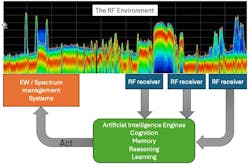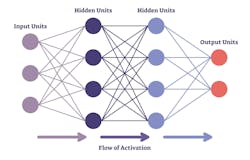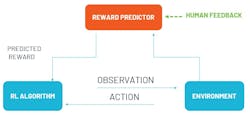The Intelligent Future of Spectrum Visibility (Part 2)
What you’ll learn:
- The rise of cognitive radar and how it’s used today.
- The current challenges in AI decision-making.
- Test and measurement challenges in the AI age.
In Part 1 of this two-part series, we covered the current challenges that confront spectrum operations in an evolving electromagnetic landscape. We also discussed the transformative role of test and measurement tools.
Here in Part 2, we highlight the paradigm shift brought forth by cognitive radar and AI's integral role in electromagnetic dominance, signifying a leap to more sophisticated and efficient spectrum management. Through examples of real-world applications, the discussion touches on the practical implications of these advances. It also addresses the inherent technical challenges that accompany the course toward a more secure and technologically adept future in the realm of spectrum operations.
The Rise of Cognitive Radar and Cognitive Spectrum Management
Early radar systems, limited as they were by fixed rules, lacked the adaptability required for dynamic threat environments. To empower radar systems to operate more effectively in new environments and situations, researchers began integrating faculties associated with biological cognition, such as perception, thinking, judging, problem-solving, and remembering, into radar systems.
One might compare a traditional radar system to early versions of automotive cruise control, which maintain a constant speed but can’t adapt to changing traffic conditions or obstacles on its own.
In contrast, cognitive radar aims to operate like a fully autonomous self-driving car equipped with AI. Such intelligent vehicles don’t simply maintain speed. Rather, they sense and understand their environment; make decisions based on real-time data regarding traffic, road conditions, and unexpected obstacles; and adapt their driving accordingly.
>>Download the PDF of this article, and check out the TechXchange for similar articles and videos
Similarly, cognitive radar continuously scans its environment, intelligently adjusting its operating parameters in response to changing conditions, and then makes autonomous decisions about how to best detect and track targets in rapidly changing and adversarial environments.
Cognitive spectrum management (CSM) represents a revolutionary shift from traditional, static spectrum management to a dynamic, intelligent system that leverages AI and machine learning. At its core, CSM uses advanced algorithms to continuously analyze patterns in spectrum usage and predict future spectrum usage based on historical and real-time data (Fig. 1).
RF instruments play a vital role in the creation and deployment of cognitive radar and CSM as extremely sensitive acquisition engines and computing nodes that can sample, process, record, and share vast amounts of spectrum data. This data feeds into AI algorithms that learn and evolve, constantly improving the system’s ability to manage the spectrum. The following are among the most popular and promising types of algorithms for cognitive RF systems:
Neural Networks and Deep Learning in Cognitive RF Systems
These algorithms are particularly effective in recognizing complex patterns in spectrum usage. Based on large training sets with diverse types of signals from known electromagnetic environments, they can map a set of inputs to a set of desired outputs.
For instance, a deep neural network (Fig. 2) can be trained to take in various types of signals received over the air (inputs) in a crowded spectrum environment. Then it can classify those signals into communication signals, radar pulses, unmanned-aircraft-system (UAS) control channels, interference, licensed or unlicensed broadcasts, and other types of categories (outputs).
Reinforcement Learning in Cognitive RF Systems
In contrast to neural networks, reinforcement-learning (RL) algorithms learn not by identifying patterns from training sets, but by perceiving the state of the environment and interacting with it (Fig. 3).
In RL, the goal is for the algorithm (the "agent") to learn a specific task or set of behaviors, like how the police trains K9 dogs to sniff out explosive substances. The RL agent learns through trial and error, exploring different actions and observing the outcomes, as the K9 would try various approaches to understand what the trainer wants it to do. The trainer gives positive outcomes (or "rewards") to the agent when it performs the right action and negative outcomes, or lack of a reward, for the wrong actions.
In the case of spectrum operations, an autonomous radio transmitter system might be rewarded for increasing the signal-to-noise ratio of its output until it starts to affect neighboring channels, changing the state of the environment, and failing to get rewards. Through experimentation, feedback, and gradual adaptation, RL agents improve their performance and learn the desired behavior or task.
The goal of this machine-learning technique is to learn a policy. Eventually, the RL agent becomes proficient in the task, consistently making choices that yield the highest rewards depending on the state of the engagement, having learned the optimal “policy” based on the state of the engagement.
To illustrate this point in radio operations, consider RL algorithms continuously sensing the environment, and then managing and adapting the frequency allocation of communication networks to avoid interference and jamming.
By receiving quantitative and qualitative feedback on current conditions and the effectiveness of each frequency choice (such as received signal strength, signal clarity, and resistance to jamming), the RL system learns to select the optimal frequencies under varying conditions. Over time, it becomes adept at predicting and avoiding frequencies likely to experience interference, ensuring more reliable communications.
Support Vector Machines in Cognitive RF Systems
Support vector machines (SVMs) are a type of supervised machine-learning algorithm used primarily for classification and regression tasks. They work by finding the decision boundary that best separates different classes of data points. SVMs excel in their ability to handle complex classification problems with clear margin of separation.
Spectrum operations systems can use SVMs to distinguish between friendly, hostile, and neutral signals. By training an SVM with examples of various signal types (including their frequency, modulation, and other characteristics), it can learn to accurately identify the nature of new signals it encounters. This is crucial for threat assessment and decision-making in spectrum operations scenarios.
In Figure 4, the spectrum-monitoring system detects and observes various transmitters both outside (red) and inside (yellow) a defined home base perimeter using received signal strength indicators (RSSI), angle of arrival (AoA), signal demodulation, and other characteristics. Here, the SVM algorithm might find a decision boundary between them by squaring their x,y location and using a plane as a decision boundary.
Time-Series Analysis in Cognitive RF Systems
In the context of machine learning and artificial intelligence, time-series analysis involves examining a sequence of data points collected over time to identify underlying patterns, trends, and correlations.
By analyzing historical data on spectrum usage, machine-learning models can forecast periods of high or low activity. This enables engineers to plan operations during times of lower congestion or prepare for expected increases in communications or jamming activities when these are most likely to occur.
Similarly, machine-learning models trained on normal spectrum usage patterns can identify anomalies when they occur. This might include unexpected spikes in signal activity or the sudden appearance of unfamiliar signal types, prompting further investigation or immediate countermeasures.
These algorithms anticipate changes and adapt proactively to enhance spectrum efficiency, minimize interference, and improve the security and reliability of spectrum operations.
AI Algorithms on Test and Measurement Instrumentation
Instruments such as arbitrary waveform generators (AWGs), vector signal generators (VSGs), and real-time spectrum analyzers (RSAs) will also benefit from AI algorithms. They will pave the way to developing real-time generation, analysis, and manipulation of high-fidelity, precision signals based on the evolving electromagnetic environment.
AI algorithms can analyze data from one or multiple synchronized RSAs to identify patterns, threats, and opportunities within the spectrum. Such algorithms will also enable AWGs to dynamically generate optimized waveforms that counteract interference, jamming, or spoofing attempts, or to adjust for more efficient spectrum usage.
This synergy facilitates the creation of responsive and adaptive testbeds for innovative spectrum management and electronic warfare (EW), where systems can learn from past actions, predict future scenarios, and make decisions to optimize performance and effectiveness in real-time.
Technical Challenges in AI Decision-Making
Although the integration of AI-driven systems into electromagnetic-spectrum operations brings transformative advantages, it also introduces a set of challenges that technologists and policy makers need to address carefully.
Acquiring and Managing High-Fidelity Field Data Records
Gathering and processing high-fidelity field RF data from realistic scenarios poses a significant challenge for researchers and engineers aiming to train cognitive systems. They require rugged RF sensors with superior RF specifications and broad bandwidth to capture and merge data from multiple locations, creating a comprehensive picture of dynamic RF environments (Fig. 5).
To train these systems effectively, teams must meticulously tag, catalog, and load vast datasets covering a broad spectrum of scenarios, frequencies, and environmental conditions. Achieving a comprehensive and representative data collection is a formidable logistical task.
The process of tagging and annotating spectrum data demands intensive labor, as experts must describe the signal type, source, and environmental context, adding crucial operational or battlefield insights.
Ensuring data labeling is consistent and accurate across extensive datasets is critical to train AI models properly, as discrepancies can degrade model performance. Moreover, preprocessing the data—normalizing, reducing noise, and extracting features—can add hours of work.
Computational Requirements for Cognitive RF Systems and AI Algorithms
Running cognitive spectrum-management algorithms, especially those employing advanced machine-learning techniques like deep neural networks, require clusters of high-end processors capable of performing trillions of floating-point operations per second (TFLOPS).
To put this into perspective, a cognitive spectrum-management system deployed in a military operation might require a computing setup that rivals or exceeds the capabilities of some of the most advanced commercial servers currently available. This setup would need to be robust enough to handle not only the computational load, but also the challenging environmental conditions often found in military contexts.
However, when it comes to inference—the process of making real-time decisions based on the trained model—the computational requirements decrease, allowing for more manageable field deployments.
Challenges for Test and Measurement Equipment
Instruments like Tektronix’s rugged RSAs face the challenges of integrating AI capabilities to help engineers understand the electromagnetic environment more clearly as well as develop cognitive spectrum operations systems more rapidly.
AI will enable test and measurement instruments to incorporate expert assistance in knowing how to gather and process high-fidelity field RF data from multiple locations and varied electromagnetic scenarios to produce a comprehensive picture of dynamic RF conditions.
On the generation side, high-bandwidth arbitrary waveform generators will evolve to assist in the dynamic design and creation of waveforms that adapt to RF conditions and measured system behavior.
AI-Driven Spectrum Operations: Staying Ahead with Quality RF Hardware
Mastering intelligent spectrum operations is crucial to staying ahead of swiftly adapting adversaries. Investing in high-quality RF hardware, sophisticated AI algorithms, and robust data-processing capabilities is key to unlocking new potentials in EW and communication.
The success of AI-driven spectrum systems depends heavily on the quality of the underlying hardware, including advanced antennas, transceivers, and digital baseband processing units capable of operating across diverse frequencies and conditions. Precision in test and measurement is essential, delivering RF sensors that capture a broad range of signals to feed accurate, high-quality data into AI models. This synergy between top-notch field data and cutting-edge computing will fuel breakthroughs in spectrum operations.
Reimagining the 1941 Pearl Harbor scenario with AI-powered radar systems illustrates the transformative power of AI. Instead of a tragic surprise, AI's predictive capabilities enable a swift and decisive response, turning a potential day of infamy into a demonstration of the strength of cognitive radar and spectrum operations. Such a scenario underscores the importance of AI in not just responding to threats, but proactively outclassing and outmaneuvering them.
References
Del Monte, L.A., Genius weapons: Artificial intelligence, autonomous weaponry, and the future of warfare. Prometheus Books, 2018.
Federal Aviation Administration. (2023). Drones by the Numbers. Retrieved January 09, 2024, from https://www.faa.gov/node/54496.
Haigh, K. Z., Andrusenko, J., Cognitive electronic warfare: An artificial intelligence approach. Artech House, 2021.
O. M. Khodayer Al-Dulaimi, M. K. Hassan Al-Dulaimi and A. M. Khodayer Al-Dulaimi, "Cognitive Radio Technologies and Applications in Dynamic Spectrum Access Method," 2022 IEEE 9th International Conference on Problems of Infocommunications, Science and Technology (PIC S&T), Kharkiv, Ukraine, 2022, pp. 9-14, doi: 10.1109/PICST57299.2022.10238684.
S. You, M. Diao and L. Gao, "Deep Reinforcement Learning for Target Searching in Cognitive Electronic Warfare," in IEEE Access, vol. 7, pp. 37432-37447, 2019, doi: 10.1109/ACCESS.2019.2905649.
U.S. Air Force (2023). Electromagnetic spectrum operations (AFDP 3-85). Retrieved January 12, 2024, from https://www.doctrine.af.mil/Portals/61/documents/AFDP_3-85/AFDP%203-85%20Electromagnetic%20Spectrum%20Ops.pdf.
Statista, “Number of IoT Devices,” 2023. Retrieved from https://www.statista.com/statistics/1183457/iot-connected-devices-worldwide/.








